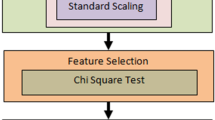Abstract
The abrasion resistance of chenille yarn is crucially important in particular because the effect sought is always that of the velvety feel of the pile. Thus, various methods have been developed to predict chenille yarn and fabric abrasion properties. Statistical models yielded reasonably good abrasion resistance predictions. However, there is a lack of study that encompasses the scope for predicting the chenille yarn abrasion resistance with artificial neural network (ANN) models. This paper presents an intelligent modeling methodology based on ANNs for predicting the abrasion resistance of chenille yarns and fabrics. Constituent chenille yarn parameters like yarn count, pile length, twist level and pile yarn material type are used as inputs to the model. The intelligent method is based on a special kind of ANN, which uses radial basis functions as activation functions. The predictive power of the ANN model is compared with different statistical models. It is shown that the intelligent model improves prediction performance with respect to statistical models.




Similar content being viewed by others
Abbreviations
- a k :
-
Coefficient of the kth independent variable
- n :
-
Number of independent variables
- b :
-
Bias term of multiple-regression models
- b i :
-
Bias term of the ith hidden neuron
- y 1 :
-
Fabric abrasion
- y 2 :
-
Yarn abrasion
- x 1 :
-
Yarn count
- x 2 :
-
Pile length
- x 3 :
-
Twist level
- x 4 :
-
Pile yarn material type
- c ik :
-
Coefficient of the interaction term x ik
- α:
-
Column data vector
- \( \bar{\varvec{\upalpha}} \) :
-
Normalized counterpart of vector α
- m :
-
Number of columns of a data vector α
- ones(m,1):
-
m×1 column vector with all elements as one
- max(α):
-
Maximum element of vector α
- min(α):
-
Minimum element of vector α
- \( \bar{\varvec{\upalpha}}\) :
-
Normalized counterpart of data vector α
- d i :
-
Input vector of the radial basis function R i
- v i :
-
Center of the radial basis function R i
- σ i :
-
Width of the radial basis function R i
- w 2 ji :
-
Weight of the ith hidden unit for the jth output node
- w 1 ji :
-
Weight of the ith input x i for the jth hidden unit
- μ:
-
Learning rate
- J :
-
Cost function
- ΔJ :
-
Change in cost function
- λ:
-
Adjusted parameter
References
ASTM D 4966–89 Standard Test Method for Abrasion Resistance of Textile Fabrics (Martindale Abrasion Tester Method)—Annual Book of ASTM Standards Vol 07.1–2
Brorens PH, Lappage J, Bedford J, Ranford SL (1990) Studies on the abrasion resistance of weaving yarns. J Text Inst 81(2):126–134
Bryan ED, Yu C, Oxenham W (1999) The abrasion characteristics of ring spun and open-end yarns. In: Proceedings of the 12th EFS research forum, pp 1–13
Çeven EK (2002) An investigation about the effect of some production parameters on yarn properties at chenille spinning machines. Msc Thesis, The University of Uludag, pp 41–131
Cheng L, Adams DL (1995) Yarn strength prediction using neural networks. Textile Res J 65(9):495–500
Cheng KPS, Lam HLI (2003) Evaluating and comparing the physical properties of spliced yarns by regression and neural network techniques. Text Res J 73(2):161–164
Chenille Background Brochure (2000) Chenille International Manufacturer’s Association (CIMA), Italy, pp 1–3
Choi KF, Kim KL (2004) Fiber segment length distribution on the yarn surface in relation to yarn abrasion resistance. Text Res J 74(7):603–606
Ethridge D, Zhu R (1996) Prediction of rotor spun cotton yarn quality: a comparison of neural network and regression algorithm. In: Proceedings of the beltwide cotton conference, vol 2, pp 1314–1317
Gong RH, Wright RM (2002) Fancy yarns, their manufacture and application. Woodhead Publishing Limited, UK
Haykin S (1994) Neural networks: a comprehensive foundation. Macmillan Publishing Company, New York
Liu Y, Ying Y, Lu H (2004) Optical method for predicting total soluble solids in pears using radial basis function networks. In: Proceedings of SPIE—the international society for optical engineering, vol 5587, pp 198–212
Majumdar PK, Majumdar A (2004) Predicting the breaking elongation of ring spun cotton yarns using mathematical, statistical, and artificial neural network models. Text Res J 74(7):652–655
Majumdar A, Majumdar P K, Sarkar B (2005) Application of linear regression, artificial neural network and neuro-fuzzy algorithms to predict the breaking elongation of rotor-spun yarns. Indian J Fibre Textile Res 30(1):19–25
McIntyre JE, Daniels PN (1995) Textile terms and definitions. The Textile Terms and Definitions Committee, Biddles Limited, UK
Oh S-H (1997) Improving the error backpropagation algorithm with a modified error function. IEEE Trans Neural Netw 8(3):799–803
Özdemir Ö, Çeven E K (2004) Influence of chenille yarn manufacturing parameters on yarn and upholstery fabric abrasion resistance. Text Res J 74(6):515–520
Pynckels F, Kiekens P, Sette S, Langenhove LV, Impe K (1997) The use of neural nets to simulate the spinning process. J Text Inst 88(4):4407–447
Rajamanickam R, Hansen SM, Jayaraman S (1997) Analysis of the modeling methodologies for predicting the strength of air-jet spun yarns. Text Res J 67(1):39–44
Ramesh MC, Rajamanickam R, Jayaraman S (1995) Prediction of yarn tensile properties using artificial neural networks. J Text Inst 86:459–469
Zhu R, Ethridge D (1997) Predicting hairiness for ring and rotor spun yarns and analyzing the impact of fiber properties. Text Res J 67:694–698
Author information
Authors and Affiliations
Corresponding author
Rights and permissions
About this article
Cite this article
Çeven, E.K., Tokat, S. & Özdemir, Ö. Prediction of chenille yarn and fabric abrasion resistance using radial basis function neural network models. Neural Comput & Applic 16, 139–145 (2007). https://doi.org/10.1007/s00521-006-0048-8
Received:
Accepted:
Published:
Issue Date:
DOI: https://doi.org/10.1007/s00521-006-0048-8




